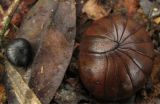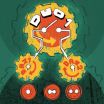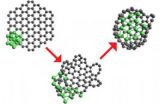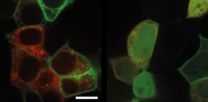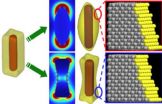(Press-News.org) One of the biggest riddles in physics is the apparent imbalance between matter and antimatter in our universe. To date, there is no explanation as to why matter and antimatter failed to completely annihilate one another immediately after the big bang and how the surplus matter was created that went on to form the universe as we know it. Experiments conducted at Johannes Gutenberg University Mainz (JGU) have contributed towards a resolution of this problem. For the first time a direct and high-precision measurement of the magnetic moment of the proton has been conducted successfully. The magnetic moment is one of the fundamental properties of protons, which combine with neutrons to form the nucleus of atoms. In principal, the method can also be used to measure the magnetic moment of an antiproton with a similarly high precision, making it possible to investigate matter/antimatter asymmetry. Related experiments are now being set up at the CERN research center in Geneva, Switzerland.
Years of preparation were necessary before the measurements were possible and the results obtained have far exceeded those of all previous attempts. In addition to Mainz University, the GSI Helmholtz Center for Heavy Ion Research in Darmstadt, the Max Planck Institute of Nuclear Physics in Heidelberg, and the Japanese RIKEN research facility all took part in the experiment. Using a double Penning trap, the researchers were able to determine the relevant parameter, the so-called 'g-factor,' with a precision of 3.3 x 10^9. The result is 760 times more precise than all the results documented independently at Mainz University and Harvard University in 2012, and three-times more precise than the result obtained by an indirect measurement in 1972.
"Protons are like tiny rod magnets. They have a magnetic moment 24 magnitudes – equal to one millionth of a billionth of a billionth – weaker than a typical compass needle. This is the first time we have been able to measure anything on this scale," said Andreas Mooser, primary author of the study and a member of Professor Jochen Walz's research team at Mainz University. The key to success proved to be the use of a double Penning trap, i.e., an electromagnetic particle trap, to isolate and evaluate a single free proton. An analysis trap serves to detect spin-quantum jumps of the proton, while in a precision trap precise frequency measurements are conducted.
It has proved possible in the past to use Penning traps to directly measure the magnetic moment of individual particles such as electrons and their antiparticle counterparts, positrons. But adapting this approach for use with protons is an enormous challenge as the magnetic moment of a proton is 660 times smaller than that of an electron. The apparatus for the experiment needed to be far more sensitive. The collaborating partners were able to develop such a highly sensitive double Penning trap so that they could undertake the long-planned measurements.
Apart from the direct measurement performed in Mainz, the previous most precise measurements were obtained by means of an indirect method in 1972, where the hyper-fine structure of atomic hydrogen was measured and subsequently theoretical corrections were applied.
The principle of a direct measurement in a double Penning trap can also be used for the antiproton. "We can then compare the two results and test these against the fundamental predictions of the standard model," explained Stefan Ulmer, coordinator of the BASE joint project, which is currently setting up a corresponding experiment at CERN in Geneva.
Using the double Penning trap technique for the antiproton could enhance the precision of results obtained during the ATRAP project in 2013 by a factor of at least 1,000. Assuming that the measured values differ, this would represent an important step forward with regard to understanding the matter/antimatter asymmetry of our universe.
INFORMATION:
Images:
http://www.uni-mainz.de/bilder_presse/08_physik_quantum_proton_01.jpg
Double Penning trap used to measure the magnetic moment of the proton. The double Penning trap is made of gold-plated cylindrical trap electrodes; the individual trap electrodes are isolated from one another using sapphire rings. During measurements the trap is in an ultra-high vacuum. To the right of the image is the outer housing of a detection instrument which allows for the observation of single protons. The entire structure is about 20 centimeters long.
photo/©: Andreas Mooser, JGU
http://www.uni-mainz.de/bilder_presse/08_physik_quantum_proton_02.jpg
The oscillating proton (red) generates a tiny current which is recorded using highly sensitive electronic detectors. The red arrow represents the magnetic moment of the proton; the green lines indicate the magnetic field in the trap.
ill./©: Georg Schneider, JGU
Publication:
Andreas Mooser et al.
Direct high-precision measurement of the magnetic moment of the proton
Nature, 29 May 2014
DOI: 10.1038/nature13388
Andreas Mooser et al.
Resolution of Single Spin Flips of a Single Proton
Physical Review Letters, 4 April 2013
DOI: 10.1103/PhysRevLett.110.140405
Magnetic moment of the proton measured with unprecedented precision
Physicists succeeded in the first direct high-precision measurement of a fundamental property of the proton / Results will contribute to a better understanding of the matter/antimatter asymmetry
2014-06-06
ELSE PRESS RELEASES FROM THIS DATE:
A new way to make laser-like beams using 250x less power
2014-06-06
ANN ARBOR – With precarious particles called polaritons that straddle the worlds of light and matter, University of Michigan researchers have demonstrated a new, practical and potentially more efficient way to make a coherent laser-like beam.
They have made what's believed to be the first polariton laser that is fueled by electrical current as opposed to light, and also works at room temperature, rather than way below zero.
Those attributes make the device the most real-world ready of the handful of polariton lasers ever developed. It represents a milestone like none ...
New species of ancient chirping giant pill-millipedes from Madagascar already threatened
2014-06-06
An international team of researchers comprised of Thomas Wesener, Museum Koenig, Bonn, Daniel Le, Field Museum, Chicago and Stephanie Loria, American Museum of Natural History, New York, discovered seven new species of chirping giant pill-millipedes on Madagascar. The study was published in the open access journal ZooKeys.
The species discovered all belong to the genus Sphaeromimus, which is Latin for 'small ball animal'. However, the designation 'small' is not always true for the members of the genus as one of the newly discovered species surprises with a size larger ...
Probiotics prevent deadly complications of liver disease
2014-06-06
Bethesda, MD (June 6, 2014) — Probiotics are effective in preventing hepatic encephalopathy in patients with cirrhosis of the liver, according to a new study in Clinical Gastroenterology and Hepatology, the official clinical practice journal of the American Gastroenterological Association. Hepatic encephalopathy is a deterioration of brain function that is a serious complication of liver disease.
"This rigorous new research finds that probiotics modify the gut microbiota to prevent hepatic encephalopathy in patients with cirrhosis of the liver," said David W. Victor III, ...
Shatterproof screens that save smartphones
2014-06-06
University of Akron polymer scientists have developed a transparent electrode that could change the face of smartphones, literally, by making their displays shatterproof.
In a recently published scientific paper, researchers demonstrated how a transparent layer of electrodes on a polymer surface could be extraordinarily tough and flexible, withstanding repeated scotch tape peeling and bending tests. This could revolutionize and replace conventional touchscreens, according to Yu Zhu, UA assistant professor of polymer science. Currently used coatings made of indium tin ...
Breakthrough study solves plant sex mystery
2014-06-06
A team of biologists from the University of Leicester has solved a mystery surrounding how plants have sex.
The researchers have discovered a pair of proteins made by flowering plants that are vital for the production of the sperm present within each pollen grain.
Scientists already knew that flowering plants, in contrast to animals, require not one, but two sperm cells for successful fertilisation: one to join with the egg cell to produce the embryo and one to join with a second cell to produce the nutrient-rich endosperm inside the seed.
The mystery of this 'double ...
Method of nickel-carbon heterofullerenes synthesis presented
2014-06-06
Scientists from several British, Spanish and Russian research centers (MIPT, Institute for Spectroscopy RAS, Kurchatov Institute and Kintech Lab Ltd) have come up with a method of synthesizing a new type of nickel-carbon compound. The article titled Formation of nickel-carbon heterofullerenes under electron irradiation has been published by Dalton Transactions and is available as a pre-print at arxiv.org. The first author of the article is Alexander Sinitsa, an MIPT student, and the leading author is Andrey Popov (Institute for Spectroscopy RAS, 1989 MIPT graduate).
Heterofullerenes ...
Mitochondrial DNA of first Near Eastern farmers is sequenced for the first time
2014-06-06
The mitochondrial DNA of the first Near Eastern farmers has been sequenced for the first time. In the research, published in the journal PLOS Genetics, experts analysed samples from three sites located in the birthplace of Neolithic agricultural practices: the Middle Euphrates basin and the oasis of Damascus, located in today's Syria and date at about 8,000 BC.
The paper is signed by Daniel Turbón and Alejandro Pérez Pérez, from the Department of Animal Biology of the University of Barcelona (UB); Eva Fernández, from Liverpool John Moores University; Cristina Gamba, Eduardo ...
Herpesviruses undercover
2014-06-06
This news release is available in German.
The Kaposi's sarcoma-associated herpesvirus (KSHV), a gammaherpesvirus that can cause multiple forms of cancer, establishes lifelong infections within the body. To do so the virus has to find a way to modulate the immune system of its host.
„Intruders are usually fought off immediately by an antiviral immune response that is triggered by sensors including the toll-like receptors (TLR)," says HZI researcher Dr. Kendra Bussey, author of the study that was published in the "Journal of Virology". Toll-like receptors detect ...
Opening a wide window on the nano-world of surface catalysis
2014-06-06
Surface catalysts are notoriously difficult to study mechanistically, but scientists at the University of South Carolina and Rice University have shown how to get real-time reaction information from Ag nanocatalysts that have long frustrated attempts to describe their kinetic behavior in detail.
The key to the team's success was bridging a size gap that had represented a wide chasm to researchers in the past. To be effective as nanocatalysts, noble metals such as Au, Pt, Pd and Ag typically must be nanoparticles smaller than 5 nm, says Hui Wang, an assistant professor ...
Exotic particle confirmed
2014-06-06
This news release is available in French. For decades, physicists have searched in vain for exotic bound states comprising more than three quarks. Experiments performed at Jülich's accelerator COSY have now shown that, in fact, such complex particles do exist in nature. This discovery by the WASA-at-COSY collaboration has been published in the journal Physical Review Letters. The measurements confirm results from 2011, when the more than 120 scientists from eight countries discovered for the first time strong indications for the existence of an exotic dibaryon made ...
LAST 30 PRESS RELEASES:
University of Oklahoma researcher awarded funding to pursue AI-powered material design
Exploring how the visual system recovers following injury
Support for parents with infants at pediatric check-ups leads to better reading and math skills in elementary school
Kids’ behavioral health is a growing share of family health costs
Day & night: Cancer disrupts the brain’s natural rhythm
COVID-19 vaccination significantly reduces risk to pregnant women and baby
The role of vaccination in maternal and perinatal outcomes associated with COVID-19 in pregnancy
Mayo Clinic smartwatch system helps parents shorten and defuse children's severe tantrums early
Behavioral health spending spikes to 40% of all children’s health expenditures, nearly doubling in a decade
Digital cognitive behavioral treatment for generalized anxiety disorder
Expenditures for pediatric behavioral health care over time and estimated family financial burden
Air conditioning in nursing homes and mortality during extreme heat
The Alps to lose a record number of glaciers in the next decade
What makes a good proton conductor?
New science reporting guide published for journalists in Bulgaria
New international study reveals major survival gaps among children with cancer
New science reporting guide published for journalists in Turkey
Scientists develop a smarter mRNA therapy that knows which cells to target
Neuroanatomy-informed brain–machine hybrid intelligence for robust acoustic target detection
Eight SwRI hydrogen projects funded by ENERGYWERX
The Lundquist Institute and its start-up company Vitalex Biosciences Announces Strategic Advancement of Second-Generation fungal Vaccine VXV-01 through Phase 1 Trials under $40 Million Competitive Con
Fine particles in pollution are associated with early signs of autoimmune disease
Review article | Towards a Global Ground-Based Earth Observatory (GGBEO): Leveraging existing systems and networks
Penn and UMich create world’s smallest programmable, autonomous robots
Cleveland researchers launch first major study to address ‘hidden performance killer’ in athletes
To connect across politics, try saying what you oppose
Modulating key interaction prevents virus from entering cells
Project explores barriers to NHS career progression facing international medical graduates
Jeonbuk National University researchers explore the impact of different seasonings on the flavor perception of Doenjang soup
Two Keck Medicine of USC Hospitals named Leapfrog Top Teaching Hospitals
[Press-News.org] Magnetic moment of the proton measured with unprecedented precisionPhysicists succeeded in the first direct high-precision measurement of a fundamental property of the proton / Results will contribute to a better understanding of the matter/antimatter asymmetry


